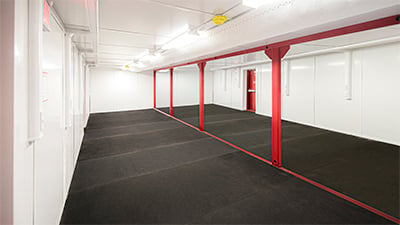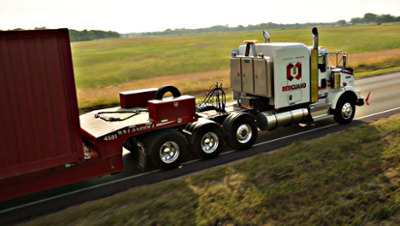Purchasing a blast-resistant building is no small responsibility to undertake. It involves months of planning (sometimes more than a year), depending on the scope of the project. Part of the due diligence on an investment of this size and magnitude is not only looking for benefits but also in looking at the challenges that one might encounter.
RedGuard has been in the blast-resistant building business since 2005, as long as the industry has been around. We’ve seen our fair share of issues that customers have faced with our buildings and with structures built by other companies. We’ve worked on many ways to minimize those problems and prevent them whenever possible, we believe it's good business to share our industry knowledge.
Here are some points on the most common problems associated with blast-resistant modular buildings, the causes, and how to avoid and mitigate problems when possible.
The following are in no particular order.
1. Blast-resistant doors are heavy!
This may come as no surprise, but blast-resistant doors are heavy, some weighing in at 450 pounds. It makes sense, since they’re blast-resistant and made of heavy steel. The weight means that they require regular maintenance and alignment to avoid sagging and out-of-alignment hinges or latches.
While it’s not common, it’s easy to see how a 450-pound door could cause injury if it were to slam on a hand or foot. These issues could also cause the door not to close properly, which, in turn, could affect the building’s efficacy in a blast event.
What can you do?
Maintenance, which should be done every 60 days, or more often in high traffic areas, could include something as easy as a visual inspection to ensure that all fasteners are tight and that hinges and latches are functioning. When wear-and-tear of these areas is found, parts may need to be replaced.
Heavy doors have hydraulic mechanisms to make opening and closing them easier, and to prevent slamming. Another part of maintenance on these doors is to check the viscosity of the fluids in those mechanisms. In areas where temperatures are subject to change, the viscosity of fluids could be affected, causing doors to slam or have difficulty latching.
If you’ve decided to take on this maintenance yourself, you’ll need to know what to look for and how often. An effective service team will be ready to either guide you through the process or come out to make regular inspections during building maintenance.
And, while the doors are heavy, it’s important to remember that they are a factor in saving lives. Doors on blast-resistant buildings should never be propped open.
2. Windows must conform to necessary blast rating
The presence of windows in a blast-resistant building design has a direct correlation to its blast-rating. This is referred to as a single degree of freedom. Since a blast-resistant building is no stronger than its “weakest” component, the area the building is located will sometimes determine the presence and size of windows.
In general, blast-resistant buildings that are designed for placement in areas that may experience a higher psi blast will need to have smaller windows. These areas are places like a factory’s alkylation unit or other areas that have toxic gases or high-pressure pipelines.
Windows in these areas typically serve a utilitarian purpose, like monitoring an area, viewing a control, or interacting with personnel. Buildings that are the closest to dangerous processes may not be able to have windows at all.
If you are leasing your blast-resistant building, this might mean that you are at the mercy of the available inventory. For this reason, it’s best to begin planning well in advance to ensure the availability when windows are required. If a window is a desired amenity but is not required, you would then follow the best practice of using a building with a higher psi rating.
3. Posts in multi-section buildings
Larger modular blast-resistant buildings are created by putting together multiple modular sections to create one open space. The interior modular sections will have posts in areas where they are connected,  creating a strong base for blast-resistance.
creating a strong base for blast-resistance.
While it is not desirable to have posts in a large, open space, the posts are a “necessary evil.” If you took them away, you would be compromising the safety of the blast-resistant design.
Other companies will point to blast-resistant tents as an alternative, especially when a large open space is required. Unfortunately, tents don’t provide the same protection as a blast-resistant steel building. And according to API RP 756, their use should be minimized in process areas.
4. No mobile or cellular reception
When you’re inside a large steel box, there’s not much that can get inside, including a signal for mobile or cellular devices. For some areas, this may not be a problem, as it may be an area that requires that workers stay off of their devices. At other times, being connected may be imperative to get a job done.
When connectivity is a must, signal repeaters can be added to blast-resistant modular buildings. These are installed in buildings to bring an outside signal into the structure.
Repeaters negate the attenuation, or loss of signal, caused by the building materials. As part of regular maintenance, your BRB provider should ensure that signal repeaters are compatible with mainstream technology.
5. Potentially out-of-date technology or accessories
The technology or accessories that we use inside of blast-resistant buildings can be just as crucial to safety as the building itself. Making sure that all of these things are up to date or current, isn’t so much a problem as it is an issue of maintenance.
Some of these things need to be regularly maintained (like fire extinguishers and smoke detectors), and other things need to be updated as their technology becomes obsolete (like the signal repeaters mentioned in #4).
This could include things like:
- Gas detection devices - should be recalibrated at regular intervals. Some companies will perform this with scheduled maintenance; others will guide the client through the process.
- Fire extinguishers - should be visually inspected at regular intervals and occasionally tested to make sure they are safe to use. If your building is leased, it should have been part of the check-list of items that were thoroughly checked before the building was deployed.
- Turnstile technology - when a plant uses turnstiles, there is often entry/ID software to go along with that. The software must be current and updated. This might be part of regular maintenance, or something that a BRB provider guides a client through.
- Smoke detectors - regular maintenance to inspect the battery and its power source are required.
- Radio extenders - similar to signal repeaters for mobile or cellular service, radio signals might also require extenders. An occasional check to make sure they are operational and updated should be done.
6. HVAC Issues
In leased buildings, the HVAC will most likely be a vertical, wall-mounted unit. These are used for leased units to maximize the building’s transportability. Unfortunately, with these units come a certain amount of noise due to vibration and noise transfer, because they are mounted to a wall.
 In purchased buildings, noise issues are typically not a problem, because the system can be pad-mounted outside the building itself. The issue of noise in leased buildings is a trade-off for the fact that you can easily get a temporary building put into place and operational in a short amount of time.
In purchased buildings, noise issues are typically not a problem, because the system can be pad-mounted outside the building itself. The issue of noise in leased buildings is a trade-off for the fact that you can easily get a temporary building put into place and operational in a short amount of time.
Another issue with HVAC systems in blast-resistant buildings is that they require more frequent maintenance due to the environment. Refineries, chemical plants, and other areas that blast-resistant buildings are placed are not known for their scenic views, but instead for air that will contain dust and atmospheric particulates that are a product of the refining process. The HVAC systems will be filtering dirty air that is harsh on the system.
To prevent problems with the HVAC system, the air filters will need to be checked regularly, possibly weekly or even daily. The filter will need to be changed more frequently than even the manufacturer’s guidelines suggest, which is generally every 30 days. (However, it is very dependent on the location, so ask the building’s manufacturer for best practices.)
It’s also important to understand that keeping the thermostat set at reasonable temperatures is expected for the efficient running of the HVAC system. Setting it too low (below 65 degrees Fahrenheit) can make the system freeze up and shut down.
More comprehensive service on a blast-resistant HVAC will need to be performed occasionally, which is also dependent on the needs at a particular site. The frequency of service will be determined by:
- The length of time on rent or lease (if it’s a leased building)
- The location
- The amount of traffic within and use of the BRB
You should be able to set up an appropriate service with your provider’s service department. Advance planning is vital since, during a more extensive service call, the electrical to the building might need to be disconnected.
7. Delivery Logistics
Blast-resistant buildings can have complicated logistics when it comes to delivery. This is due to several factors, but weight, size, permitting, and scheduling could all come into play. If the delivery is made during a busy turnaround, that could also be a factor.
When it comes to permits, requirements can vary by state. Your delivery team will work with you to make sure all the proper permits are in place, that bonded or approved routes are followed when necessary, and all of the required pilot cars are used.
It’s important to remember that these factors could affect the cost of the delivery. A reputable vendor will work with you in advance, to make sure everything is in place, and you should ask questions if you’re unsure of details.
On location, there are a few things to consider too. Mitigating factors, like if there are specific gates that need to be used, or if there are any clearances that need to be obtained by drivers or technicians, can be crucial.
It’s also important to make sure that all of the necessary resources are onsite. Some BRB deliveries require the use of large cranes. The transportation department will want to make sure that the delivery of the building will not be competing to use resources.
8. The bottom is not blast-resistant
Because the blast-resistant building is built to sit on a level surface and the bottom won’t have contact with a blast wave, the bottom of a building does not have blast-resistance. This is not an issue unless it is exposed or placed on a surface that is not level.
It’s critical to work with a vendor’s specialists to make sure that blast-resistance is not compromised.
Making sure the bottom of the building is not exposed is the key to avoiding this issue. In some settings, a belly pan can go on the unit to protect the bottom. Other instances may allow a building to be “shimmed” to make it a level surface. Shimming is acceptable, as long as any gaps left between the ground and the building are filled in with gravel or dirt. The bottom of the building should never be exposed, for example, over a ledge, or similar surface, nor should it be placed on solid blocks for leveling.
9. Lack of Availability
Availability is probably the biggest challenge with blast-resistant buildings. When it comes to leasing, there is only a finite number available for lease.
Reserve what you need early. The same is true when purchasing buildings. Getting a vendor involved early in your process can help you deal with any of the issues described above that could affect your timeline.
In summary
Hopefully, this gives you a better understanding of the problems, challenges, and issues that you might encounter with blast-resistant buildings and the ways to either prevent or mitigate them. Luckily, the problems aren't really problems, just factors to prepare for.
At RedGuard, we understand the need to address all of these issues associated with blast-resistant buildings. We also understand that vendors and their products should be carefully scrutinized. The safety of your team comes first, and we welcome an open discussion about your site plan and needs when you’re ready to start planning.
Carreen Gibbons
Carreen Gibbons is the Communications Specialist at RedGuard. With a natural curiosity toward technical subjects and a love of learning new things, she writes content for the SiteBox Storage and RedGuard websites and spends her days learning new things about the industries that the companies serve.




